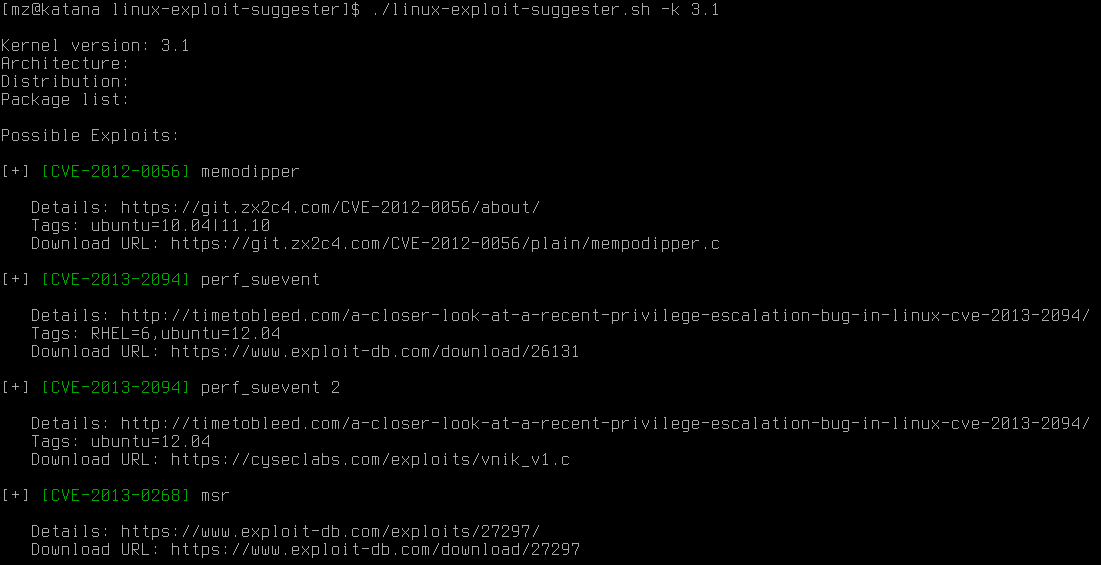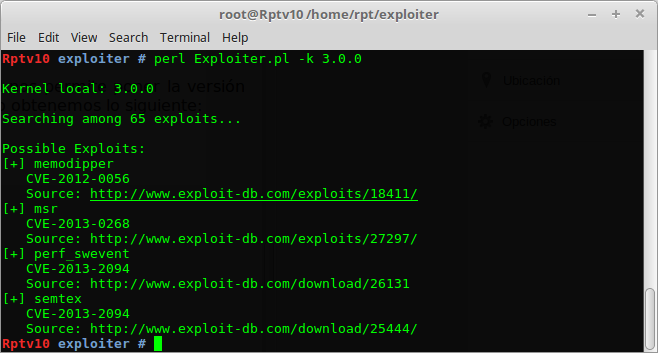

- #Linux exploit suggester how to#
- #Linux exploit suggester update#
- #Linux exploit suggester Patch#
- #Linux exploit suggester windows 10#
- #Linux exploit suggester code#
Thanks for this great tool which has served many of us for so many years! Bugs The Microsoft Security Bulletin Data Excel file has not been updated since Q1 2017, so later operating systems and vulnerabilities cannot be detected. This is because Microsoft replaced the Microsoft Security Bulletin Data Excel file on which GDSSecurity’s Windows-Exploit-Suggester is fully dependent, by the MSRC API.
#Linux exploit suggester windows 10#
I developed WES-NG because while GDSSecurity’s Windows-Exploit-Suggester worked excellently for operating systems in the Windows XP and Windows Vista era, GDSSecurity’s Windows-Exploit-Suggester does not work for operating systems like Windows 10 and vulnerabilities published in recent years. csv file which is compressed and hosted in this GitHub repository. NIST National Vulnerability Database (NVD): Complement vulnerabilities with Exploit-DB links These are combined into a single.
#Linux exploit suggester update#
MSRC: The Microsoft Security Update API of the Microsoft Security Response Center (MSRC): Standard source of information for modern Microsoft Updates.Microsoft Security Bulletin Data: KBs for older systems.The WES-NG collector pulls information from various sources: Executing these scripts will produce definitions.zip. Read the comments at the top of each script and execute them in the order as they are listed below. csv file with hotfix information is required, use the scripts from the /collector folder to compile the database. This GitHub repository regularly updates the database of vulnerabilities, so running wes.py with the -update parameter gets the latest version. For an overview of all available parameters, check CMDLINE.md.
#Linux exploit suggester how to#
Additionally, make sure to check the Eliminating false positives page at the Wiki on how to interpret the results.



WES-NG is a tool based on the output of Windows’ systeminfo utility which provides the list of vulnerabilities the OS is vulnerable to, including any exploits for these vulnerabilities. ** Unknown Source Repository at this time.Windows Exploit Suggester – Next Generation (WES-NG)
#Linux exploit suggester code#
Provided for research only, Perform a through code review prior to use, use only hosts you have legal authority to pentest no warranties or guarentees implied or provided!.Version numbers with 0’s indicate ALL subversions of that Kernel portion (e.g.Using this listing, locate exploit refereces that includes your version.Locate the Kernel version of the target machine(s) (e.g.This also seems to be based on the same Github Project only he’s added more (the author tweeted about that too). I copied the whole page here as the source page looks like a work in progress. Source: Flat file to find Linux Exploits by Kernel version Additionally possible to provide ‘-k’ flag to manually enter the Kernel Version/Operating System Release Version.
#Linux exploit suggester Patch#
Nothing fancy, so a patched/back-ported patch may fool this script. This program run without arguments will perform a ‘uname -r’ to grab the Linux Operating Systems release version, and return a suggestive list of possible exploits. Linux Exploit Suggester is a github project to identify exploits based on operating system release number(or Kernel version). The first one is available in Github and the second one I believe I saw in Twitter and bookmarked the link (can’t remember the Twitter handle, sorry, please remind me so that I can credit?). Both of these resources can suggest Linux exploits based on kernel version. I found two good references that may be helpful or least will give you a good starting point. Sometimes it’s really hard to find the correct exploit for the device that you are pentesting.


 0 kommentar(er)
0 kommentar(er)
